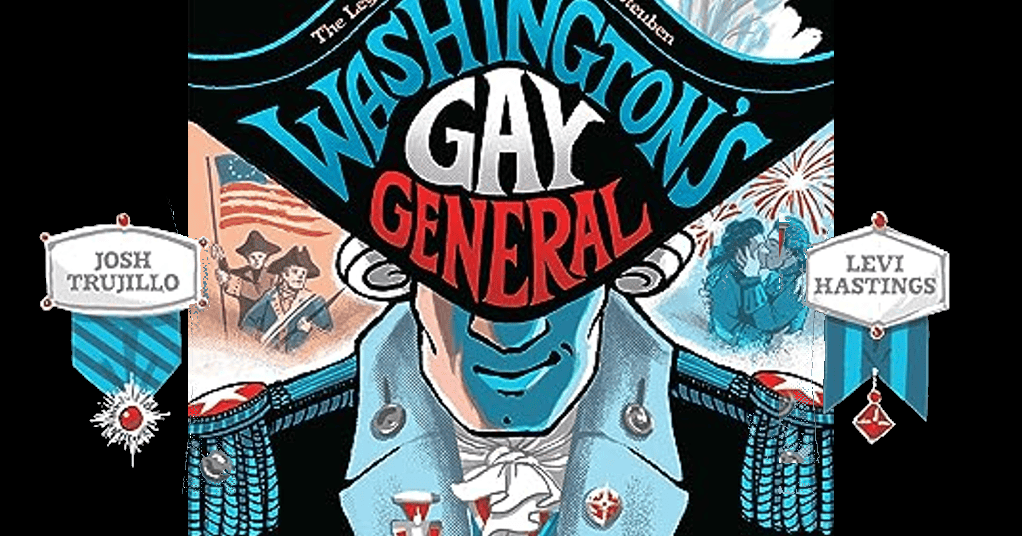How do you tell the story of queer historical figures when you do not know how they would have identified, exactly how they viewed their sexuality? How do you balance historical methodology with modern terminology to piece together the story of one of the American Revolution’s most pivotal figures, well, Josh Trujillo and artist Levi Hastings asked themselves this question and succeeded.
What the book is, is a graphic novel that is as much about the man writing it as it is about the titular Fredrick Von Steuben. It did not even begin with Von Steuben, as Josh Trujillo says while sitting at his table at AwesomeCon, “Levi Hastings and I worked on a short romance comic called Declaration. It was only about eight pages, but we took it to some conventions, and we kept selling out. So, people…when they came to our table, they would say, oh, you have to do a comic about Baron von Steuben. And we’re like, that sounds amazing. Who is Baron Von Steuben?”
This question of who this man was became the center of a Wikipedia rabbit hole, that turned into a research fest, and an episode of Drunk History, culminating with the graphic novel Washington’s Gay General. But beyond the obvious biographical tale of Baron Von Steuben is the question of how do we tell queer stories, and celebrate queer figures, and what do the people that lived hundreds of years ago have to tell us?
Friedrich Wilhelm von Steuben was a decorated Prussian military officer who was given the impossible task of helping a bunch of farmers fight the greatest superpower of the period, Great Britain. “He really taught the American military to be a military.” Josh Trujillo continued “And he somehow came up with strategies that would help us win against Britain, which was the major superpower of the day.” But beyond that, what appealed to Trujillo about this man, “I just kind of saw a very disciplined, but at the same time, messy gay, who had an ill-behaved dog, and younger lovers, and was always aspiring to get to the top and lied his way to get there. And I just thought that was so compelling.”
As Trujillo noted, in recent years, and thanks, in part to works like Hamilton, there is an interest in a critical look at the founding fathers. “And I wanted to kind of give him the same treatment.”
One thing that makes the comic, and Von Steuben’s life so interesting, is the fact that he lied, or creatively bent the truth to make himself more interesting, and appealing to get what he wanted. Well-illustrated in the comic is how he changed his rank to achieve more in the military than he had before. “And it’s not that he wasn’t talented, [its] that he didn’t actually have the rank that he was claiming to.” He could have gotten in big trouble had he been caught. His intelligence and occasional bending of the truth allowed him to climb the military ladder. “He kept getting promoted and promoted and promoted.”
The biographical book goes into not only Von Steuben’s life but the life of its author. One challenge was how to make it personal. “Because this is a guy that lived about 300 years ago. And it’s hard to know what he was really like some of the accounts say he was kind of a very stern man. He liked to cuss. He barely spoke English. And so, trying to read a personality from that was a little difficult.” The editors came through delivering advice that brought the story to a deep, personal connection, to put themselves in the book. “Levi and myself are there and we’re navigating some of these questions about gender and love and sexuality and marriage, the how do we compare anything we know and experience today to what life was like in the revolutionary days.”
What comes of the book, is a deeply personal look at not just Von Steuben’s life, but that of a few other incredible queer stories, including two seamstresses who lived together their entire lives, wrote sapphic poetry, and were seemingly completely accepted by their loved ones. And not to forget, Public Universal Friend, a person who after a religious awakening changed their name, dressed in gender-neutral clothing, and became a religious leader.
These discoveries surprised Trujillo, “discovering stuff like that is like, Oh, wow, these aren’t new inventions, these identities, this is something that’s always existed, and also that they were surrounded by, you know, a wealth of people who supported them and made them so powerful in the first place.”
Trujillo praised Hastings’s incredible art, his talent, and “his mastery of color.” The use initial idea had been to use red, white, and blue, “But in trying to use the red on the interior, I think it came off a little too harsh.” Trujillo explains, “…visually, the blues are a little more inviting, they’re a little calmer. And that seemed to suit the story of well.” The color palette ended up being black, blue, and white, but allowed for the colors to be intermixed to create amazing textures and layers in smoke and fire.
Hastings and Trujillo navigate this with an incredibly illustrated comic that utilizes a simple, but meaningful color scheme to get its point across. It adds a nice, historical approach that is entertaining and intellectually provocative.
